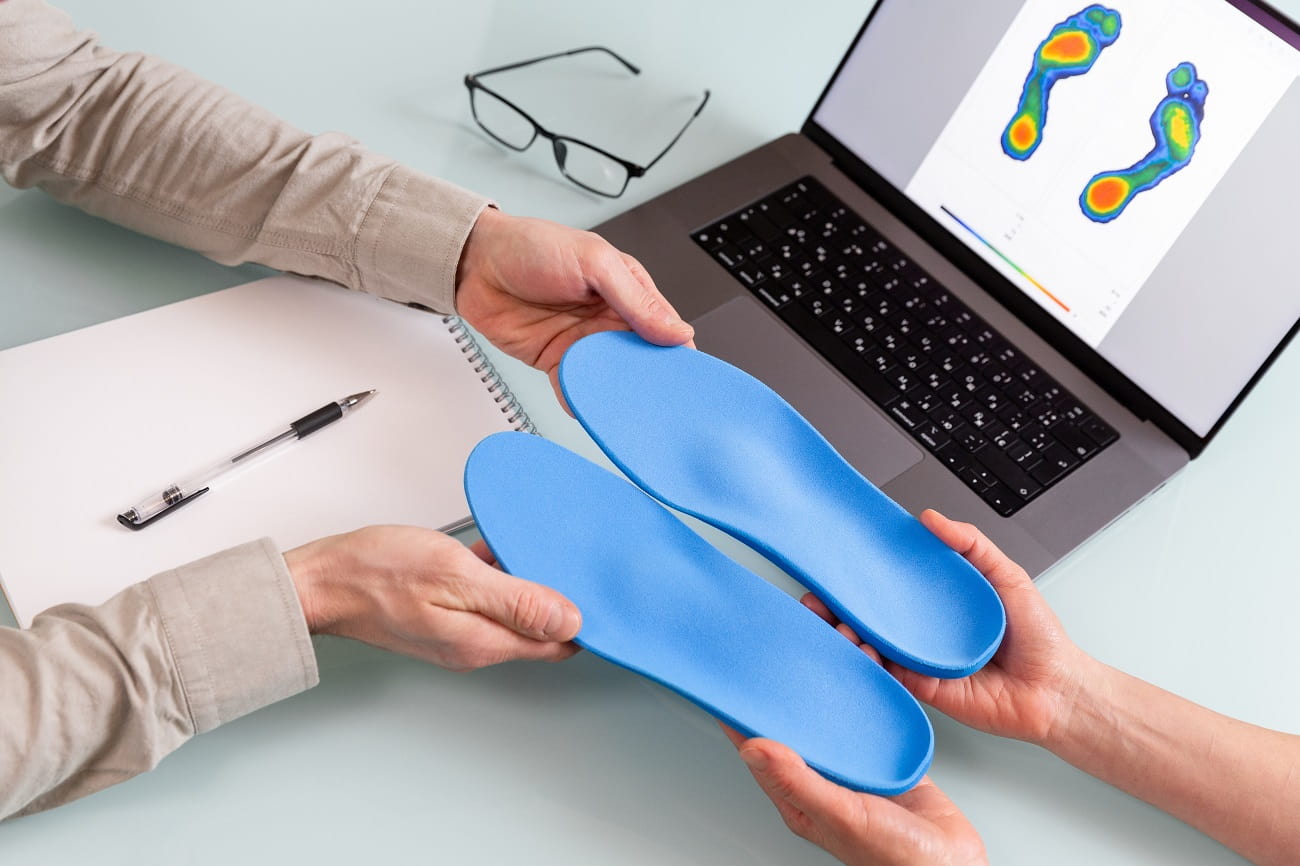The ability to be on your feet shouldn’t be taken for granted, especially for those suffering from ankle arthritis. This is a degenerative disease, however, when it is caught early, it can be slowed and pain minimized. If you’re in need of ankle-foot orthotics in Albuquerque & Las Cruces and are seeking osteoarthritis in the feet treatment, please reach out to our team to see how we can assist you.
What Is Osteoarthritis of the Ankle?
Those with healthy ankles have cartilage that covers the surface of the bones that meet. This protective padding prevents the bones from rubbing together. However, in those with osteoarthritis in the ankle, the cartilage slowly wears down, causing the bones to rub against one another and resulting in painful bone spurs.
According to research, the leading cause of osteoarthritis in ankles is trauma and it’s usually a result of a rotational injury that causes bone fractures and ligament sprains.
Ankle Osteoarthritis Causes

Osteoarthritis in the foot and ankles doesn’t have a sole cause. Despite the range of situations in which it might develop, it is caused by the general wearing down of the cartilage on the bones between the joints. There could be many factors that contribute to its development, but regarding ankle osteoarthritis, the main cause is a previous ankle injury. According to research, 78% of all ankle osteoarthritis cases result from previous ankle trauma.
Even with the right treatment, an injured ankle joint is 7x more likely to develop arthritis compared to one that is uninjured. Despite the ankle generally being a stable joint composed of three bones, there is only a thin layer of cartilage. Consider the fact that your ankles support the weight of your entire body, adding a significant level of stress to these small joints.
Here are some factors that can increase your chances of having osteoarthritis in the ankle:
- Age: It’s possible for OA to occur at any stage of life, however, it’s more common in older adults;
- Obesity: When your body has to bear more weight, it adds stress to your ankles. Fat cells can produce proteins that can make OA worse;
- Injuries: Any ankle injury, even one that occurred years ago, can lead to OA;
- Repeated stress: When there’s high-impact stress on your ankles over a long period of time, it can increase your risk of OA;
- Genetics: There could be a family history of OA;
- Joint shape: Those with misaligned joints are at a higher risk of developing OA.
Ankle Osteoarthritis Symptoms
Being aware of osteoarthritis in ankle symptoms can help you detect it sooner. The symptoms are similar to those of arthritis, and those who experience OA in the ankle may experience the following symptoms:
- Pain and stiffness in the ankle that feels worse in the morning or after sitting for long periods;
- Tenderness when the joint is squeezed or touched;
- Swelling around one side or the entire ankle joint, especially when activity levels increase;
- Redness around the joint;
- Difficulty bending or flexing the joint and experiencing pain while doing so;
- An overall decreased range of motion;
- Difficulty walking without pain or pain when putting weight onto the ankle.
Keep in mind that osteoarthritis in the ankle can also impact your emotional and mental well-being in addition to your physical well-being.
Ankle Osteoarthritis Treatment
The Arthritis Foundation (AF) outlines various treatment options including medications, non-drug measures, and for some patients, surgery. Let’s take a look at the different options you might consider.
Non-Drug Treatments
The first step in treating arthritis is typically non-drug treatments as they aren’t invasive and can be a good first line of defense. Make sure to work with a licensed healthcare provider to help develop a treatment plan that makes sense for your particular injury. Common medical interventions include:
- Shoe inserts that your doctor recommends can help alleviate some of the pressure that’s put on the ankle joint while standing or walking. This helps to discourage the ankle while rolling. There are different types of inserts depending on the type of shoe that you have.
- Rocker shoes have rounded soles meaning they require less flexion of the ankle while you are walking.
- Physical therapy is another way to strengthen the soft tissues around the muscles which has the potential to help remove pressure from the ankle and increase its range of motion.
- Foot orthoses including canes and braces can help to stabilize the ankle and remove the pressure.
- Medications such as over-the-counter oral medications, prescription medications, and topical medications can help alleviate pain.
Drug Osteoarthritis Foot Treatments

If the above options don’t work, you can opt for various drug treatment options in the form of injections, pills, or creams.
Common examples of pills include acetaminophen (Tylenol) to help relieve pain or nonsteroidal anti-inflammatory drugs (NSAIDs) such as ibuprofen (Advil) to help reduce inflammation and pain. Ideally, you’ll use acetaminophen before you turn to NSAIDs.
Creams include lidocaine to help reduce pain, NSAID creams such as Voltaren and Aspercreme, or salicylates, which are medications that decrease pain. Manufacturers often combine salicylates with other ingredients to create products such as Bengay.
You can also opt for injections such as betamethasone (Celestone Soluspan) that provide short-term relief. However, your doctor will only give this 3-4 times per year.
Surgical Osteoarthritis Ankle Joint Treatments
Another more drastic option for osteoarthritis of the foot and ankle treatment is surgery. This is usually the best treatment for osteoarthritis in the ankles when your problems are not relieved via other less invasive treatment options. There are different surgical procedures depending on your pain and mobility:
- Arthrodesis: This fuses the ankle bones together and reduces pain by removing motion in the ankle;
- Arthroscopic surgery: This consists of removing bone spurs and loose cartilage, something that can help some people. However, doctors don’t often use this approach for osteoarthritis;
- Total ankle replacement: Also referred to as arthroplasty, a total ankle replacement consists of removing damaged bone and cartilage and replacing it with plastic or metal parts. The result is that the patient is able to have more mobility and movement when compared with an ankle fusion surgery. Those with advanced ankle arthritis usually opt for this procedure as it will give them the best results;
- Debridement: This is usually a minimally invasive surgery that uses arthroscopy. During this procedure, the surgeon cleans out the area of foreign tissue in addition to bone spurs, inflamed tissue that lines the joint, and bone spurs.
Depending on the surgery that you get and the intensity of your previous symptoms, you might need anywhere from 4-9 months to recover. However, most patients are able to resume their normal activities in 3-4 months.
Many times, doctors recommend wearing a brace for ankle osteoarthritis during the recovery period, and there are special shoes that can support the healing process. Physical therapy is often key to helping patients regain ankle strength and slowly expand their range of motion. Keep in mind that the majority of people who have ankle osteoarthritis won’t ever need surgery.
Ankle Osteoarthritis Risk Factors

Here are some risk factors that increase the chances of developing OA:
- Joint misalignment;
- Previous injury or overuse;
- Obesity;
- Age, especially those 40 or older;
- Having an improper gait that puts too much pressure on the ankle joint.
Genetics can also play a factor in OA development. If you have family members with it, you might be more likely to develop it. However, it’s possible for anyone to develop osteoarthritis. If you think that you’re suffering from ankle osteoarthritis, you’ll want to seek osteoarthritis in the ankle treatment as soon as possible.
Ankle Osteoarthritis Diagnosis
According to the American Academy of Orthopedic Surgeons (AAOS), the following are the details surrounding the diagnostic process.
First, a physical examination takes place during which the doctor will look for tenderness and swelling. He or she will ask questions such as:
- When the pain started;
- If you had previous injuries;
- Where the pain is;
- Whether the pain comes and goes;
- How the ankle feels while walking;
- If the pain is worse during the morning.
A gait analysis is often next. Limping is a sign of stiffness and pain and can help identify the severity and location of the injury.
Other aspects included in the gait analysis include:
- Testing the ankle and foot strength;
- Stride measurement;
- Assessing how the bones align while walking.
From there, your doctor will recommend osteoarthritis ankle pain treatment that suits your needs.
Tips for Ankle Osteoarthritis

In addition to seeking treatment for osteoarthritis in the foot and ankle, there are overall tips that we recommend if you’re experiencing pain or discomfort. Ideally, you’ll be able to work on simple and gentle exercises such as swimming, cycling, or walking. These don’t add stress to the ankle and can help you maintain your range of motion.
Certain sports should be avoided altogether, including:
- Soccer;
- Kickboxing;
- Running;
- Tennis.
All of these add too much pressure to the feet and ankles and can make existing injuries worse. If possible, seek guidance from a physical therapist to build strength in the ankle.
There is various range of motion exercises to do at home such as tracing the ABCs in the air with the weaker ankle. If this is too much, start slowly and aim for only a slight stretch. You can do these exercises 3-10 times per day depending on your pain.
Summary
If you’re experiencing pain in the foot or ankle that you simply can’t ignore, it’s best to seek the help of a professional. If you don’t seek treatment, the injury will only get worse. Our team at Prime Care is here to help ensure that you get the care that you need. Contact us for an ankle osteoarthritis consultation today!

.svg)
.svg)









